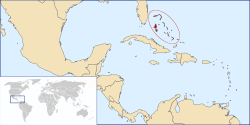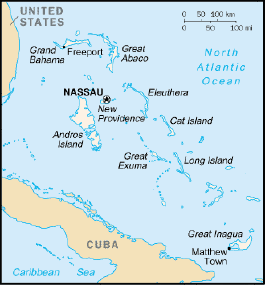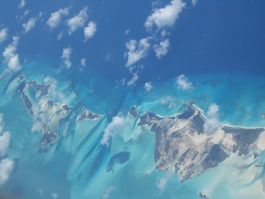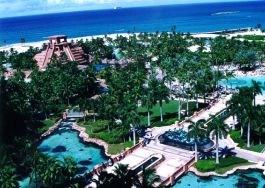The Bahamas
| Commonwealth of the Bahamas | |||||
| |||||
| Motto: "Forward Upward Onward Together" | |||||
| Anthem: March On, Bahamaland Royal anthem: God Save the Queen | |||||
| Capital | Nassau 25°4′N 77°20′W | ||||
|---|---|---|---|---|---|
| Largest city | capital | ||||
| Official languages | English | ||||
| Government | Commonwealth | ||||
| - Monarch | Elizabeth II | ||||
| - Governor-General | Arthur Dion Hanna | ||||
| - Prime Minister | Perry Christie | ||||
| Independence | from the United Kingdom | ||||
| - Self-governing | 1963 | ||||
| - Full independence | July 10, 1973 | ||||
| Area | |||||
| - Total | 13,878 km² (160th) 5,358 sq mi | ||||
| - Water (%) | 28% | ||||
| Population | |||||
| - 2005 estimate | 323,0001 | ||||
| - 1990 census | 254,685 | ||||
| - Density | 23.27/km² 60/sq mi | ||||
| GDP (PPP) | 2005 estimate | ||||
| - Total | $6.524 billion | ||||
| - Per capita | $17,8432 | ||||
| HDI (2004) | |||||
| Currency | Dollar (BSD)
| ||||
| Time zone | EST (UTC−5) | ||||
| - Summer (DST) | EDT (UTC−4) | ||||
| Internet TLD | .bs | ||||
| Calling code | +1-242 | ||||
The Commonwealth of the Bahamas is an English-speaking nation consisting of seven hundred islands and cays that form an archipelago. It is located in the Atlantic Ocean, east of Florida and the United States, north of Cuba and the Caribbean, and northwest of the British dependency of the Turks and Caicos Islands.
Geography
The Islands Of The Bahamas form a 100,000-sq-mile archipelago that extends over 500 miles of what is considered by many to be the clearest water in the world. The 700 islands, including uninhabited cays and large rocks, total an estimated land area of 5,382 sq miles, and register a highest land elevation of 206 ft. [1]
The closest island to the United States is Bimini also known as the gateway to the Bahamas. The island of Abaco is to the east of Grand Bahama. The most southeastern island is Inagua. Other notable islands include Andros Island, Eleuthera, Cat Island, Long Island, San Salvador, Acklins, Crooked Island, Exuma and Mayaguana. Nassau is the capital and largest city, located on New Providence. The islands have a subtropical climate, moderated by the Gulf Stream.
In the southeast, the Caicos Islands and the Turks islands, and three more extensive submarine features called Mouchoir Bank, Silver Bank, and Navidad Bank, are geographically a continuation of the Bahamas islands, but not part of the Commonwealth of the Bahamas.
Climate
The climate of the Bahamas is subtropical to tropical, and is moderated significantly by the waters of the Gulf Stream, particularly in winter. Conversely, this often proves very dangerous in the summer and autumn, when hurricanes pass near or through the islands. Hurricane Andrew hit the northern islands in 1992, and Hurricane Floyd hit most of the islands in 1999. Hurricane Frances of 2004 was expected to be the worst ever for the islands. Also in 2004, the northern Bahamas were hit by a less potent Hurricane Jeanne. In 2005 the northern islands were once again struck this time by Hurricane Wilma. In Grand Bahama, tidal surges and high winds destroyed homes and schools, floated graves and made roughly 1,000 people homeless, most of whom lived on the west coast of the island. The homeless people were stuck without food, water and resources.
History
Paleo-Indians may have populated the area previously, Taino Indians from Hispaniola and Cuba moved into the southern Bahamas around the seventh century AD and became the Lucayans. There were an estimated forty thousand Lucayans at the time of Columbus' arrival.
Christopher Columbus's first landfall in the New World was on the island of San Salvador, also called Watling's Island, in the south part of Bahamas. Here, Columbus made contact with the Lucayans and exchanged goods with them.
The Bahamian Lucayans were taken to Hispaniola as slaves; in two decades, many Lucayan societies ceased to exist, as the population endured considerable forced labour, warfare, disease, emigration and outmarriage. After the Lucayan population was decimated, the Bahamian islands were virtually unoccupied until the English settlers came from Bermuda in 1647. The so-called Eleutherian Adventurers established settlements on the island of Eleuthera.
The Bahamas became a British crown colony in 1718. Some 8,000 loyalists and their slaves moved to the Bahamas in the late 1700s from New York, Florida and the Carolinas.The United Kingdom Emancipation Act took force on August 1, 1834, thereby ending slavery in the Bahamas. This led to many fugitive slaves from the US braving the perils of the Atlantic for the promise of a free life in the Bahamas.
The British made the islands internally self-governing in 1964. In 1973, the Bahamas became fully independent but retained its membership of the Commonwealth of Nations. In circumstances recalling those of the southern United States, the country's black majority was economically oppressed and socially excluded, until the election of Sir Lynden Pindling and his government toward the end of the 1960s.
Based on the pillars of tourism and financial services, the Bahamas' economy has prospered since the 1950s. Today, the country enjoys the third highest per capita income in the western hemisphere, and the highest in the Caribbean (excluding the dependent territories of Bermuda and the Cayman Islands). Despite this, the country still faces significant challenges in areas such as education, healthcare, international narcotics traffiking, correctional facilities and illegal immigration. The urban renewal project has been launched in recent years to help build up dilapidated urban areas and social decline in the main islands.
Some say the name "Bahamas" derives from the Spanish baja mar, meaning "shallow seas"; others trace the name to the Lucayan word for Grand Bahama Island, ba-ha-ma ("large upper middle land").
Government and politics
The Bahamas is an independent country which is a member of the Commonwealth of Nations. Political and legal traditions closely follow those of the United Kingdom.
The non-resident Queen of the Bahamas is the ceremonial head of state, represented by a Bahamian governor-general. Prime Minister is the head of government and is the leader of the party with the most seats in the elected House of Assembly. The current Governor is Arthur Dion Hanna and the current Prime Minister is Perry Christie. The upper house (the Senate) is appointed. Executive power is exercised by the cabinet. Legislative power is vested in both the government and the two chambers of parliament.
The party system is dominated by the centre-left Progressive Liberal Party and the centre-right Free National Movement. A handful of splinter parties have been unable to win election to parliament. These parties include the Bahamas Democratic Movement, the Coalition for Democratic Reform and the Bahamian Nationalist Party.
Constitutional safeguards include freedom of speech, press, worship, movement, and association. The Bahamas is a member of the Caribbean Community. The Judiciary is independent of the executive and the legislature. Jurisprudence is based on English common law.
Demographics
Eighty-five percent of the Bahamian population is of African heritage. About two-thirds of the population lives on New Providence Island (the location of Nassau). And about half of the remaining one-third lives on Grand Bahama (the location of Freeport).
The islands were sparsely settled and a haven for pirates until the late 1700s when thousands of British loyalists and their slaves were given compensatory land grants following the American Revolution. At the turn of the 20th century the total population was only 53,000.
School attendance is compulsory between the ages of five and 16. There are 158 public schools and 52 private schools in The Bahamas catering to more than 66,000 students. The College of The Bahamas, established in Nassau in 1974, provides programmes leading to bachelors and associate degrees. The college is now converting from a 2-year to a 4-year institution.
Demographic data from the CIA World Factbook
Population
- 303,770
- note: Estimates for this country explicitly take into account the effects of excess mortality due to AIDS; this can result in lower life expectancy, higher infant mortality and death rates, lower population and growth rates, and changes in the distribution of population by age and sex than would otherwise be expected (July 2005 est.)
Age structure
- 0-14 years: 27.5% (male 41,799/female 41,733)
- 15-64 years: 66.1% (male 98,847/female 102,074)
- 65 years and over: 6.4% (male 7,891/female 11,426) (2006 est.)
Median age
- Total: 27.8 years
- Male: 27.1 years
- Female: 28.6 years (2006 est.)
Population growth rate
- 0.64% (2006 est.)
Birth rate
- 17.57 births/1,000 population (2006 est.)
Death rate
- 9.05 deaths/1,000 population (2006 est.)
Net migration rate
- -2.17 migrant(s)/1,000 population (2006 est.)
Sex ratio
- At birth: 1.02 male(s)/female
- Under 15 years: 1 male(s)/female
- 15-64 years: 0.97 male(s)/female
- 65 years and over: 0.69 male(s)/female
- Total population: 0.96 male(s)/female (2006 est.)
Infant mortality rate
- Total: 24.68 deaths/1,000 live births
- Male: 30.29 deaths/1,000 live births
- Female: 18.96 deaths/1,000 live births (2006 est.)
Life expectancy at birth
- Total population: 65.6 years
- Male: 62.24 years
- Female: 69.03 years (2006 est.)
Total fertility rate
- 2.18 children born/woman (2006 est.)
HIV/AIDS
- Adult prevalence rate: 3% (2003 est.)
- People living with HIV/AIDS: 5,600 (2003 est.)
- Deaths: less than 200 (2003 est.)
Nationality
- Noun: Bahamian(s)
- Adjective: Bahamian
Ethnic groups
- black 85%, white 12%, Asian and Hispanic 3%
Religions
- Baptist 35.4%, Anglican 15.1%, Roman Catholic 13.5%, Pentecostal 8.1%, Church of God 4.8%, Methodist 4.2%, other Christian 15.2%, none or unspecified 2.9%, other 0.8% (2000 census)
Languages
- English (official), Creole (among Haitian immigrants) and Spanish (among Cuban immigrants)
Literacy
- Definition: age 15 and over can read and write
- Total population: 95.6%
- Male: 94.7%
- Female: 96.5% (2003 est.)
ReferencesISBN links support NWE through referral fees
Template:CIA WFB 2006 and the 2003 U.S. Department of State website.
Culture and sports
Bahamian culture is a hybrid of African and European influences. Perhaps its most expression is a rhythmic form of music called Junkanoo. Aside from Junkanoo, other indigenous forms of music include rake and scrape, calypso, and a unique form of hymnal, known internationally through the music of the late Joseph Spence. Marching bands are also an important part of life, playing at funerals, weddings and other ceremonial events.
In the less developed outer islands - islands outside the capital Nassau, known as the "Out Islands" or "Family Islands" - crafts include basketry made from palm fronds. This material, commonly called "straw," is also plaited into hats and bags that are popular tourist items today.
Regattas are important social events in many family island settlements. They usually feature one or more days of sailing by old-fashioned work boats, as well as an onshore festival.
Some settlements have festivals associated with the traditional crop or food of that area, such as the "Pineapple Fest" in Gregory Town, Eleuthera or the "Crab Fest" on Andros. Other significant traditions include story telling.
A strongly religious country, there are more places of worship per person in the Bahamas than many other nations in the world. The islands are overwhelmingly Protestant Christian (over 80%). Baptists form the largest denomination (about one third), followed by the Anglican and Roman Catholic churches. As of 2006, one out of 191 in the population was a Jehovah's Witness [citation needed].
A few people, especially in the southern and eastern islands, practice Obeah, a spiritistic religion similar to Voodoo. Voodoo is also practiced by the large number of immigrants from Haiti, Cuba, Jamaica, and Dominican Republic. While well-known throughout the Bahamas, Obeah and Voodoo are shunned by many Bahamians.
Officially, the national sport of the Bahamas is cricket. However, this fact is not widely known nor is cricket widely played in the Bahamas. Although British sports like cricket, soccer and rugby have some following, American sports such as basketball, softball, baseball and American football are more popular. In addition, track and field is very popular in the Bahamas.
Bahamians have won Olympic gold medals in sailing (Sir Durwood Knowles and Cecile Cooke in 1964), and track and field (Tonique Williams-Darling in the 400m, 2004) and women's relay team (the 4 by 100m in 2000).
See also
- Bermuda Triangle
- List of Bahamas-related topics
- Bahamians
- Bahamian English
- Bahamian-Americans
- Celebrity residents of the Bahamas
- Tongue of the Ocean
- Communications in the Bahamas
- Foreign relations of the Bahamas
- Military of the Bahamas
- Transport in the Bahamas
- Postage stamps and postal history of the Bahamas
- The Scout Association of the Bahamas
Notes
- ↑ About The Bahamas, The Islands Of The Bahamas. Retrieved April 11, 2007.
Sources and further reading
General history
- Cash Philip et al. (Don Maples, Alison Packer). The Making of the Bahamas: A History for Schools. London: Collins, 1978.
- Albury, Paul. The Story of The Bahamas. London: MacMillan Caribbean, 1975.
- Miller, Hubert W. The Colonization of the Bahamas, 1647–1670, The William and Mary Quarterly 2 no.1 (Jan 1945): 33–46.
- Craton, Michael. A History of the Bahamas. London: Collins, 1962.
- Craton, Michael and Saunders, Gail. Islanders in the Stream: A History of the Bahamian People. Athens: University of Georgia Press, 1992
Economic history
- Johnson, Howard. The Bahamas in Slavery and Freedom. Kingston: Ian Randle Publishing, 1991.
- Johnson, Howard. The Bahamas from Slavery to Servitude, 1783–1933. Gainesville: University of Florida Press, 1996.
- Storr, Virgil H. Enterprising Slaves and Master Pirates: Understanding Economic Life in the Bahamaz. New York: Peter Lang, 2004.
Social history
- Johnson, Wittington B. Race Relations in the Bahamaz, 1784–1834: The Nonviolent Transformation from a Slave to a Free Society. Fayetteville: University of Arkansas, 2000.
- Shirley, Paul. "Tek Force Wid Force," History Today 54, no. 41 (April 2004): 30–35.
- Saunders, Gail. The Social Life in the Bahamas 1880s–1920s. Nassau: Media Publishing, 1996.
- Saunders, Gail. Bahamas Society After Emancipation. Kingston: Ian Randle Publishing, 1990.
External links
- Official website for Bahamas government
- Official website for Bahamas Tourist Office
- Travel guide to Bahamas from Wikitravel
- Bahamas Financial Services Board
- The Association of International Banks & Trust Companies in The Bahamas
- The Bahamas Constitution
- Bahamian Studies Online
- CIA World Factbook entry on Bahamas
- Rum Cay, Bahamas
| International membership |
|
Template:Caricom Template:Commonwealth Realms Template:Commonwealth of Nations |
Credits
New World Encyclopedia writers and editors rewrote and completed the Wikipedia article in accordance with New World Encyclopedia standards. This article abides by terms of the Creative Commons CC-by-sa 3.0 License (CC-by-sa), which may be used and disseminated with proper attribution. Credit is due under the terms of this license that can reference both the New World Encyclopedia contributors and the selfless volunteer contributors of the Wikimedia Foundation. To cite this article click here for a list of acceptable citing formats.The history of earlier contributions by wikipedians is accessible to researchers here:
The history of this article since it was imported to New World Encyclopedia:
Note: Some restrictions may apply to use of individual images which are separately licensed.




